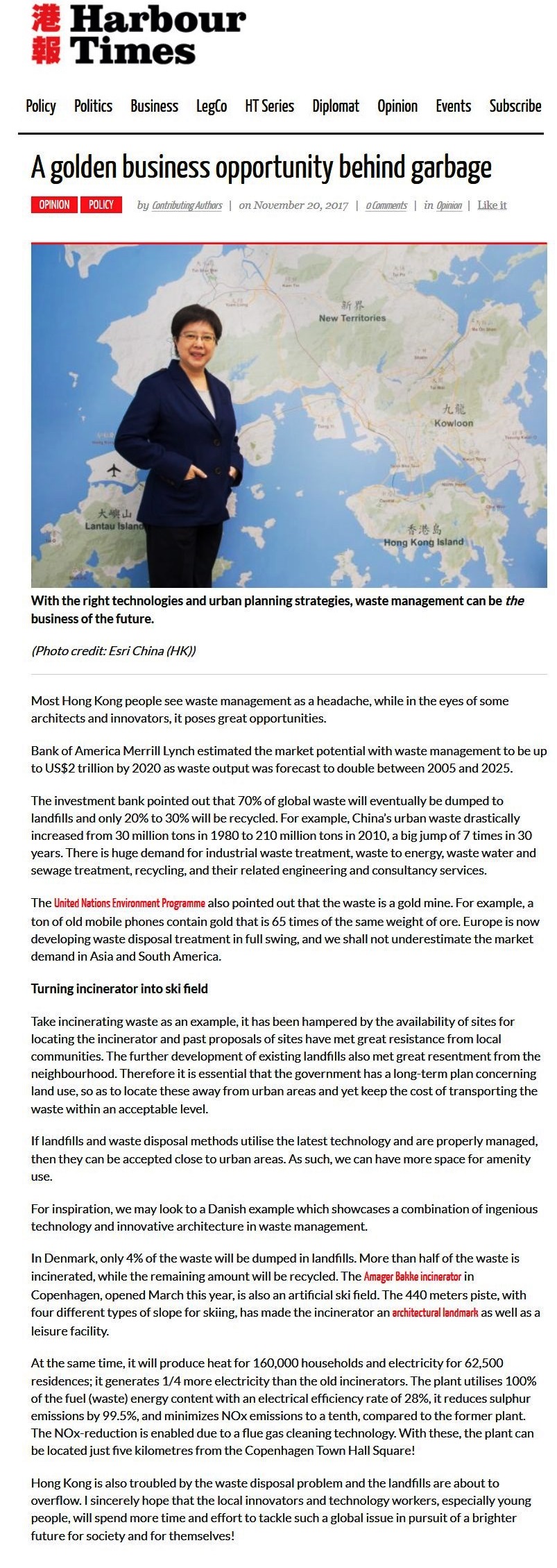網上版請按此

A golden business opportunity behind garbage
Most Hong Kong people see waste management as a headache, while in the eyes of some architects and innovators, it poses great opportunities.
Bank of America Merrill Lynch estimated the market potential with waste management to be up to US$2 trillion by 2020 as waste output was forecast to double between 2005 and 2025.
The investment bank pointed out that 70% of global waste will eventually be dumped to landfills and only 20% to 30% will be recycled. For example, China's urban waste drastically increased from 30 million tons in 1980 to 210 million tons in 2010, a big jump of 7 times in 30 years. There is huge demand for industrial waste treatment, waste to energy, waste water and sewage treatment, recycling, and their related engineering and consultancy services.
The United Nations Environment Programme also pointed out that the waste is a gold mine. For example, a ton of old mobile phones contain gold that is 65 times of the same weight of ore. Europe is now developing waste disposal treatment in full swing, and we shall not underestimate the market demand in Asia and South America.
Turning incinerator into ski field
Take incinerating waste as an example, it has been hampered by the availability of sites for locating the incinerator and past proposals of sites have met great resistance from local communities. The further development of existing landfills also met great resentment from the neighbourhood. Therefore it is essential that the government has a long-term plan concerning land use, so as to locate these away from urban areas and yet keep the cost of transporting the waste within an acceptable level.
If landfills and waste disposal methods utilise the latest technology and are properly managed, then they can be accepted close to urban areas. As such, we can have more space for amenity use.
For inspiration, we may look to a Danish example which showcases a combination of ingenious technology and innovative architecture in waste management.
In Denmark, only 4% of the waste will be dumped in landfills. More than half of the waste is incinerated, while the remaining amount will be recycled. The Amager Bakke incinerator in Copenhagen, opened March this year, is also an artificial ski field. The 440 meters piste, with four different types of slope for skiing, has made the incinerator an architectural landmark as well as a leisure facility.
At the same time, it will produce heat for 160,000 households and electricity for 62,500 residences; it generates 1/4 more electricity than the old incinerators. The plant utilises 100% of the fuel (waste) energy content with an electrical efficiency rate of 28%, it reduces sulphur emissions by 99.5%, and minimizes NOx emissions to a tenth, compared to the former plant. The NOx-reduction is enabled due to a flue gas cleaning technology. With these, the plant can be located just five kilometres from the Copenhagen Town Hall Square!
Hong Kong is also troubled by the waste disposal problem and the landfills are about to overflow. I sincerely hope that the local innovators and technology workers, especially young people, will spend more time and effort to tackle such a global issue in pursuit of a brighter future for society and for themselves!
Dr. Winnie Tang
Honorary Professor, Department of Computer Science, The University of Hong Kong